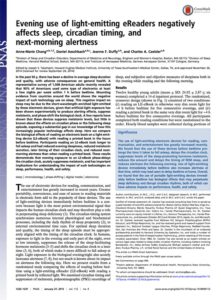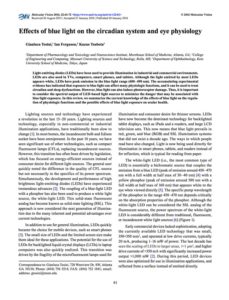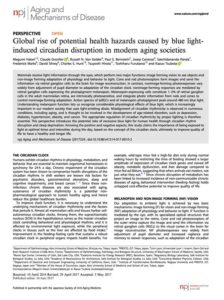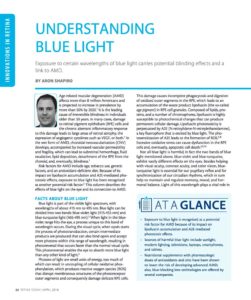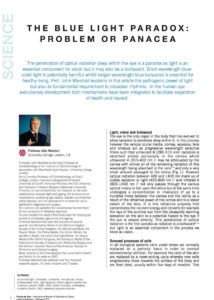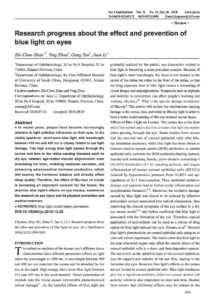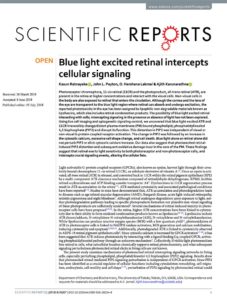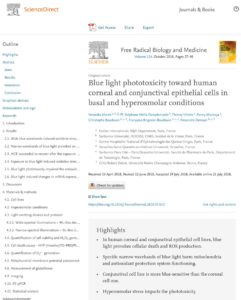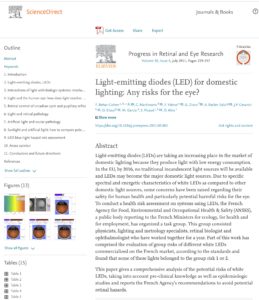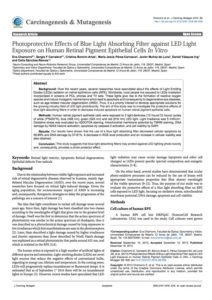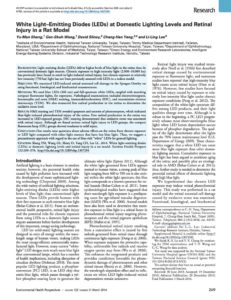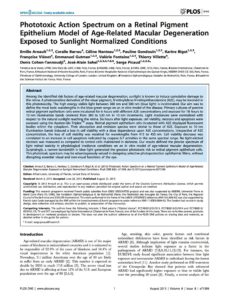Blue Light & Device Use Health Impacts Research Summary – these articles are the most frequently requested and highest priority resources from our research compendium:
Evening use of light-emitting eReaders negatively affects sleep, circadian timing, and next-morning alertness
Anne-Marie Chang, Daniel Aeschbach, Jeanne F. Duffy, and Charles A. Czeisler
Proceedings of the National Academy of Sciences (PNAS)
January 2015
Key points:
- This study demonstrates that use of a light-emitting electronic device in the hours before bedtime can have significant impact on sleep, alertness, and the circadian clock.
- Technology use in the hours before bedtime is most prevalent in children and adolescents, more studies on development and cognitive impacts are needed.
- The acute responses to the short-wavelength–enriched light emitted by devices may have longer-term health consequences than previously considered.
- Digital displays at night may have negative cognitive and developmental impacts
Effects of blue light on the circadian system and eye physiology
Gianluca Tosini, Ian Ferguson, and Kazuo Tsubota
Molecular Vision
January 2016
Key points:
- Blue light impacts the circadian rhythm
- Blue light sends non-image forming (NIF) signals to biological clock through retinal ganglion cells ipRGCs
- ipRGCs play a major role in non-image- forming photoreception, that is, the photoreceptive system that regulates circadian photic entrainment, pupillary light response, and other important biologic functions
- light in the 460 nm range is more effective in phase-shifting the circadian system than exposure to light of longer duration and higher irradiance.
Global rise of potential health hazards caused by blue light-induced circadian disruption in modern aging societies
Megumi Hatori, et al.
NPJ – Aging and Mechanisms of Disease
June 2017
Key points:
- Disturbance of circadian rhythms is also associated with other health effects:
- Chronic impairment of the circadian system has been shown to compromise health: disruptions of the circadian rhythms in shift workers are known risk factors for psychiatric disorders, gastrointestinal alterations, sleep and cognitive impairments, and breast cancer
- Blue light’s impact on circadian rhythm and sleep has serious health consequences
Understanding blue light
Aron Shapiro
Retina Today
April 2016
Key points:
- Blue light can be divided into two bands: blue-violet light (415-455 nm) and blue-turquoise light (465-495 nm).
- blue-violet range: risk of phototoxicity linked to macular degeneration (AMD) due to impact of blue light on lipofuscin precursors during the normal visual cycle.
- Not all blue light is harmful; blue-turquoise light, besides helping with visual acuity, contrast acuity, and color vision, is essential for our pupillary reflex and for synchronization of our circadian rhythms, which in turn help to maintain and regulate memory, mood, and hormonal balance.
The blue light paradox: Problem or panacea
John Marshall
Points de Vue – International Review of Ophthalmic Optics
February 2017
Key points:
Blue light can be divided into two bands: blue-violet light (415-455 nm) and blue-turquoise light (465-495 nm).
blue-violet range: risk of phototoxicity linked to macular degeneration (AMD) due to impact of blue light on lipofuscin precursors during the normal visual cycle.
Not all blue light is harmful; blue-turquoise light, besides helping with visual acuity, contrast acuity, and color vision, is essential for our pupillary reflex and for synchronization of our circadian rhythms, which in turn help to maintain and regulate memory, mood, and hormonal balance.
Research progress about the effect and prevention of blue light on eyes
Zhi-Chun Zhao, Ying Zhou, Gang Tan, and Juan Li
International Journal of Ophthalmology
December 2018
Key points:
- Blue light has been shown to increase reactive oxidative species (ROS) production in various retinal cell types
- Blue light regulates circadian rhythm, but in excess causes disruption and sleep disorders
- Overview of blue light impacts and prevention
Blue light excited retinal intercepts cellular signaling
Kasun Ratnayake, John L. Payton, O. Harshana Lakmal, and Ajith Karunarathne
Scientific Reports
July 2018
Key points:
- This technical article, cited in the media, demonstrates that when blue light hits the molecule called retinal, involved in the visual cycle, it triggers a cascade of chemical reactions that could be toxic to cells in the retina of the eye.
- Retinal photoexcited by blue light induces cytotoxicity
- Lab experiments in vitro shows how blue light can damage cells in the eye
Blue light phototoxicity toward human corneal and conjunctival epithelial cells in basal and hyperosmolar conditions
Veronika Marek, Stephane Melik-Parsadaniantz, and Thierry Villette
Free Radical Biology & Medicine
October 2018
Key points:
- Blue light induced cell death and significant ROS production, and altered the expression of inflammatory genes and operation of the cellular defensive system.
- We established for the first time that hyper-osmolar stress impacted phototoxicity, further suggesting that DED patients might be more sensitive to blue light ocular toxicity.
- Blue light can damage cells of the eye cornea, people who already have dry eyes are likely to be more sensitive to blue light.
Management of digital eye strain
Chantal Coles-Brennan, Anna Sulley, and Graeme Young
Clinical and Experimental Optometry
January 2019
Key points:
- Blue light from digital devices may contribute to symptoms of visual fatigue, since blue light scatters in the eye, increasing the effort needed to maintain visual focus.
- blue light filtering lenses and precision spectral filters, may help to reduce symptoms of digital eye strain
Light-emitting diodes (LED) for domestic lighting: Any risks for the eye?
Francine Behar-Cohen, et al.
Progress in Retinal and Eye Research
July 2011
Key points:
- The absorption spectrum of the lens changes with age. In young children, more than 65% of blue light is transmitted to the retina. At around 25 years, only 20% of the light between 400 and 460 nm and 50% of wavelengths between 400 and 500 nm are transmitted. With increasing age, the yellow filters of the lens increase and absorb most of the blue light.
Photoprotective effects of blue light absorbing filter against LED light exposure on human retinal pigment epithelial cells in vitro
Eva Chamorro, et al.
Journal of Carcinogenesis & Mutagenesis
December 2013
Key points:
- Our results have shown that the use of a blue light absorbing filter decreased cellular apoptosis and DNA damage.
- A decrease in ROS level production and an increase in cellular viability was also obtained.
- This study suggests that blue light absorbing filters may protect against LED lighting photo toxicity and, consequently, provides a photo protector effect.
White light-emitting diodes (LEDs) at domestic lighting levels and retinal injury in a rat model
Yu-Man Shang, et al.
Environmental Health Perspectives
March 2014
Key points:
- H&E staining and TEM revealed apoptosis and necrosis of photoreceptors, which indicated blue-light induced photochemical injury of the retina.
- Free radical production in the retina was increased in LED-exposed groups. IHC staining demonstrated that oxidative stress was associated with retinal injury.
- Our results raise questions about adverse effects on the retina from chronic exposure to LED light compared with other light sources that have less blue light.
Phototoxic action spectrum on a retinal pigment epithelium model of age-related macular degeneration exposed to sunlight normalized conditions
Emilie Arnault, et al.
PLOS ONE
August 2013
Key points:
- Our results defined the precise spectrum of light retinal toxicity in physiological irradiance conditions on an in vitro model of age-related macular degeneration
- A2E was found to be a photosensitizer triggering cell death in human RPE cells
- results suggest that the 415–455 nm spectral range may be the most damaging light for patients at risk for ARMD.
- Our result suggests that filtering light in a narrower band from 415 nm to 455 nm may be sufficient to prevent or limit the AMD disease development or progression.
